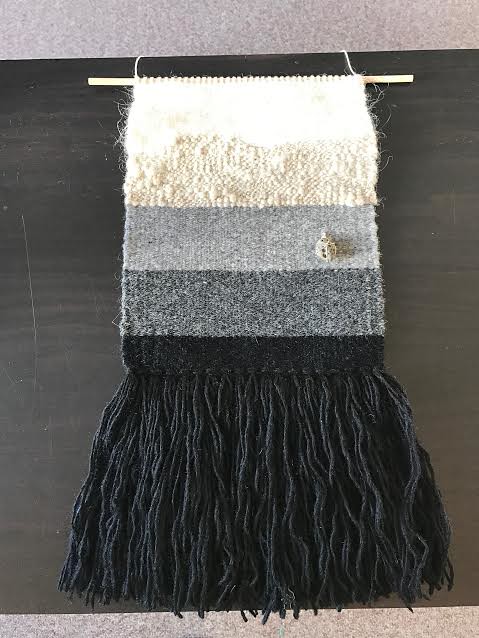A while back, I mentioned that I'd learned to weave on a frame loom. I took a class a friend of mine taught at the store, and I'm so glad that I did it! We built our own looms, and learned a few different stitch techniques. Or I would've if I hadn't plowed on through and finished my tapestry ahead of everyone else.
This is the one I wove in that class. I gifted it to a friend that let me stay at her place for 3 weeks while she was out of town and I was homeless after the breakup. She's a wonderful friend, and volcanologist to boot (that will make more sense when you read the description below).
It's mostly Icelandic wool, either commercially spun (top white and bottom black) or handspun (dark grey and bobbly cream), but the medium grey was Briggs & Little Heritage yarn. The item attached to the medium grey is actually a piece of vesicular basalt (volcanic rock with gas bubbles) wrapped with silver and sewn onto the tapestry. I was really inspired by the gorgeous shades of the Icelandic and of the layering that can occur with extrusive volcanism (lava flows). The whole thing was an ode to Iceland's geology, really.
I really love how this turned out, but the bobbly handspun second from the top intrigued me! See the little hill in the contact with the white? That formed naturally from larger bobbles stacking up as I wove. I really wanted to play with the nature of this yarn, and so the inspiration for my next design was born.
For this one, I just wanted to play with the thick-thin texture of the cream handspun, so I paired it with an evenly spun black commercial Icelandic wool and alternated rows of each yarn. I messed up the first part of the tapestry since I initially tried weaving the handspun over and under every two strands (called the warp threads), but this really affected the texture and smoothed out the effect that I wanted. I'd also planned to use some white commercially spun Icelandic wool to try to show off the distortions, but I didn't like the effect (and only realized well after it was too late to pull it out). Ah well.
It was fun to see how the handspun would stack up. There was actually a lot more extreme waves in the fat white section above, but the thick sections started to line up to fill in the thin sections, and I wound up with less extreme waves.
On the other hand, there was less chance for the handspun to "fix" itself in the narrower bands, and they formed some cool waves. I love the texture of this tapestry.
And since it's one of my favourite features of my previous tapestry, I made sure to include a thick rhya at the bottom.
I was a bit lazier with this tapestry though. On the previous one, I weaved in all of the warp threads at both the top and the bottom. This time, I just wove in the ones at the end so they wouldn't protrude and hid the rest behind the rhya. Haha GO LAZINESS!
This tapestry was started before I moved into my new apartment in March, and was made as a "welcome to your new home" for myself. It was an essential thing to focus on when I was feeling so lost, since I find weaving really captures my focus and attention. Especially one like this, where I was really experimenting with the material and engrossed in the results.
Expect to see more tapestries from me in the future! They're so fun to do. I do need to make some for the store, since my friend has really hooked people into this art form.
~~~*~~~*~~~*~~~*~~~*~~~
As an aside, this is the first time I really felt artistic in a long time. Unlike with the majority of my knitting and sewing, I felt like I wasn't just following instructions but actually using my artistic spirit to create something unique. Not that knitting or sewing can't be artistic, nor that others haven't created works of art in those mediums, but I never felt that way in regards to my own work; I don't consider myself an artist when it comes to sewing or knitting, but I definitely felt like one with these tapestries. What do you think? Do you feel like an artist, or at least, artistic when sewing or knitting? I always feel like I'm making pretty but practical items. I guess practical can be artistic as well, but I guess it comes from a prairie farming background, where you make what you need because it's necessary - hard to look at those skills as artistic as well.








